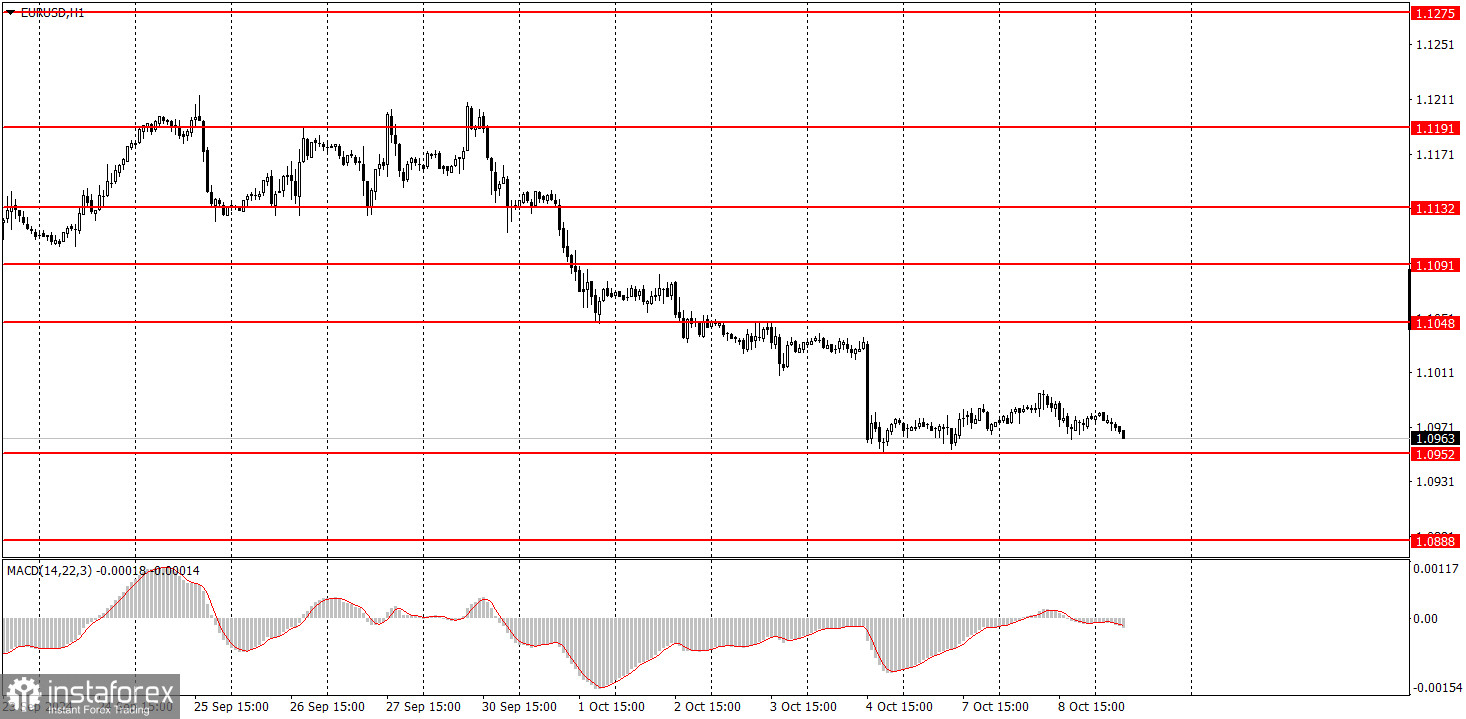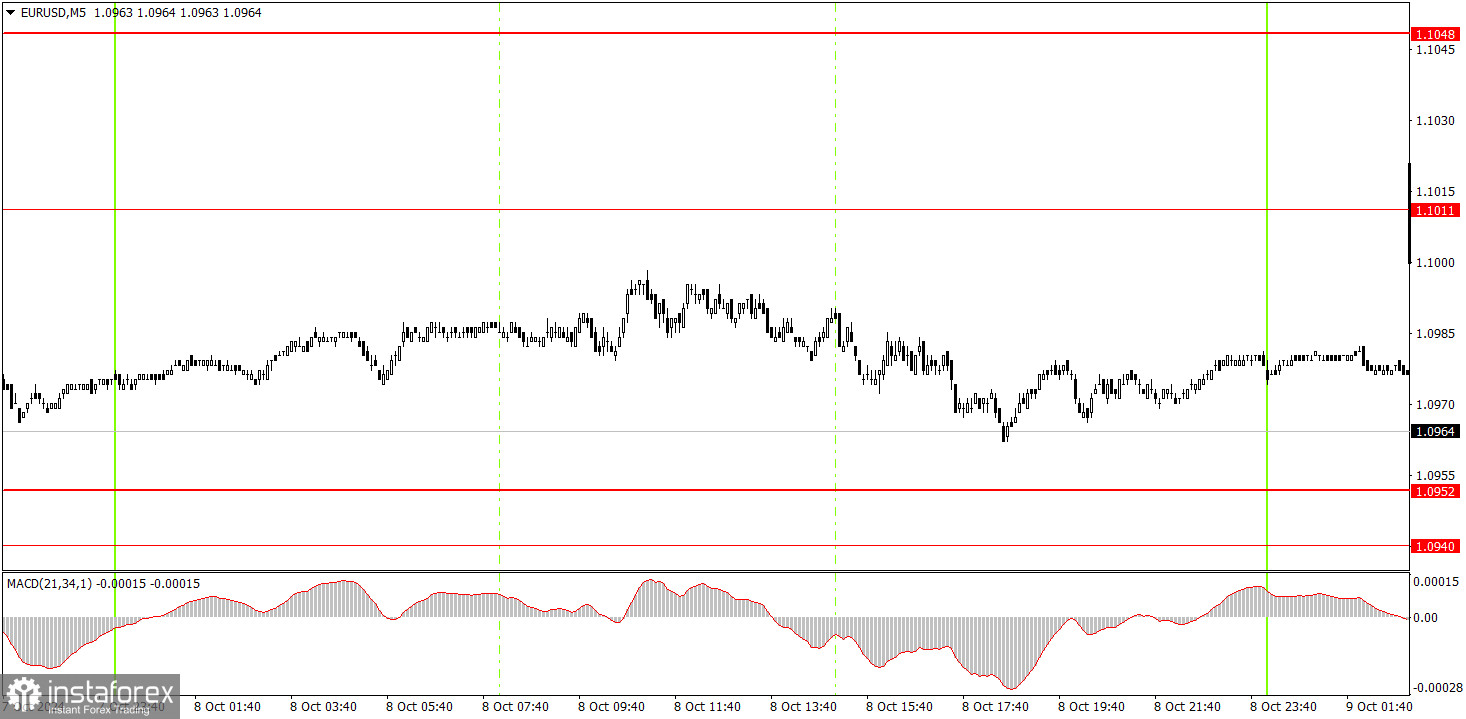Analysis of Tuesday's Trades:
1H Chart of the EUR/USD Pair

The EUR/USD currency pair again failed to correct on Tuesday. After a five-day decline, the price reached the 1.0952 level but failed to rise even by 100 pips. At the moment, it is again moving down toward this level, and we believe this development is entirely logical. We have repeatedly stated that the euro is overbought and unjustifiably expensive. Throughout 2024, the euro grew much more frequently than the fundamental and macroeconomic background warranted. The market focused only on factors related to the anticipated easing of the Federal Reserve's monetary policy. We also warned that once the Fed's policy easing began, the dollar would have no further reasons to decline, as the market had already priced in the entire cycle of rate cuts in advance. At present, the pair is much closer to a new decline than to any meaningful correction.
5M Chart of the EUR/USD Pair

In the 5-minute time frame on Tuesday, the price did not form any trading signals and remained in a flat trend throughout the day. Volatility was low, and the pair is again leaning toward a decline. The situation might change after the inflation report is released, but for now, it seems that the U.S. dollar will continue to strengthen even without a correction.
How to Trade on Wednesday:
The EUR/USD pair moved significantly toward a new downtrend last week in the hourly time frame. Unfortunately, the dollar's irrational selling could resume in the medium term, as no one knows how much longer the market will continue to adjust to the Fed's monetary easing. However, a downtrend is still present on the hourly chart. After a correction (or even without it), further declines in the euro can be expected, as it remains extremely overbought.
On Wednesday, trading can be based around the 1.0951 level. Since the euro has fallen for five consecutive days, a correction this week would be pretty logical, so some slight euro growth should be anticipated. However, breaking below this level will allow the dollar to continue its expected rise.
In the 5-minute time frame, consider trading around the following levels: 1.0726-1.0733, 1.0797-1.0804, 1.0838-1.0856, 1.0888-1.0896, 1.0940, 1.0951, 1.1011, 1.1048, 1.1091, 1.1132-1.1140, 1.1189-1.1191, 1.1275-1.1292. On Wednesday, no significant events are scheduled in the Eurozone or the U.S., so volatility will likely remain low, with very sluggish movements expected.
Basic Rules of the Trading System:
- The strength of a signal is determined by the time it takes to form (bounce or break through a level). The less time it takes, the stronger the signal.
- If two or more trades were opened near a particular level based on false signals, all subsequent signals from that level should be ignored.
- In a flat market, any pair can generate a lot of false signals or none at all. In any case, it's best to stop trading at the first signs of a flat market.
- Trades should be opened during the period between the start of the European session and the middle of the US session, after which all trades should be manually closed.
- In the hourly time frame, it's preferable to trade based on MACD signals only when there is good volatility and a trend confirmed by a trendline or trend channel.
- If two levels are very close to each other (between 5 and 20 pips), they should be treated as a support or resistance zone.
- When moving 15 pips in the intended direction, a Stop Loss should be set to breakeven.
What's on the Charts:
Support and Resistance Price Levels: These levels serve as targets when opening buy or sell positions. They can also be used as points to set Take Profit levels.
Red Lines: These represent channels or trend lines that display the current trend and indicate the preferred trading direction.
MACD Indicator (14,22,3): The histogram and signal line serve as an auxiliary indicator that can also be used as a source of trading signals.
Important Speeches and Reports (always found in the news calendar) can significantly impact the movement of a currency pair. Therefore, trading should be done with maximum caution during their release, or you may choose to exit the market to avoid a sharp price reversal against the preceding movement.
For Beginners Trading on the Forex Market: It's essential to remember that not every trade will be profitable. Developing a clear strategy and practicing money management is key to achieving long-term success in trading.
 English
English 
 Русский
Русский Bahasa Indonesia
Bahasa Indonesia Bahasa Malay
Bahasa Malay ไทย
ไทย Español
Español Deutsch
Deutsch Български
Български Français
Français Tiếng Việt
Tiếng Việt 中文
中文 বাংলা
বাংলা हिन्दी
हिन्दी Čeština
Čeština Українська
Українська Română
Română

